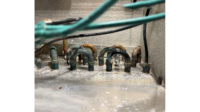In December 2020, Congress passed the American Innovation and Manufacturing (AIM) Act, which gave the Environmental Protection Agency (EPA) the authority to phase down HFCs to 15% of their baseline levels by 2036. The phasedown officially started at the beginning of 2022, with a 10% reduction in the production of HFC refrigerants, such as R-410A and R-404A, and an even steeper cut will be enacted in 2024.
The phasedown is having its intended effect, as prices of HFCs are climbing and will likely rise even more as certain refrigerants become harder to find. This could hit food retailers particularly hard, as commercial refrigeration systems are notoriously leaky, and continually topping them off is becoming a very expensive proposition. This problem can be lessened by implementing a comprehensive leak detection and mitigation program, which was discussed at a recent AHRI webinar.
Utility Partners
Those looking for help in implementing a leak detection and mitigation program may not have to look further than their local utilities. While decarbonization efforts have led utilities to stick primarily to electrification and weatherization programs, they are now starting to look at ways to support refrigerant leak mitigation in order to further reduce emissions, said Ali White, senior engineering consultant at VEIC in Winooski, Vermont.
“We made the case in Vermont and elsewhere that refrigerants are 4% to 6% of total state emissions, and they're typically lumped into industrial processes rather than building emissions,” she said. “As we all know, they are a source of emissions in buildings, so they really are the low-hanging fruit of greenhouse gases that utility efficiency programs that are switching to decarbonization metrics could be going after.”
White added that in Vermont, they found energy savings to be associated with most of their refrigerant management measures. By combining the energy and non-energy savings, an ideal bridge was created for utilities to go from strictly looking at kilowatt-hour savings to broadening that to greenhouse gas savings as well.
In Vermont, the refrigerant management program took a four-pronged approach:
- Proactive refrigerant leak detection and repair;
- Refrigerant retrofits to lower-GWP refrigerants;
- Natural refrigerant systems, where applicable; and
- Reduced system charge size, either through installing a glycol loop or designing systems to have a smaller refrigerant charge.
White said that this approach was implemented during several pilot programs, which relied on permanent leak detection systems and/or significant submetering in individual grocery stores to gather data. The results of the leak detection and repair program were encouraging, with 50 projects being completed between 2019 and 2021.
“The projects add a lot of non-energy value to both contractors and end users,” said White. “The total carbon savings impact per year was 5.4 million pounds CO2e (2,450 metric tons), and the average leak reduction was 12%. That was through a combination of large custom storewide audits and permanent leak detection systems and also a smaller program geared towards small and medium business customers.”
Average annual estimated energy savings per project was 25,000 kWh, or $2,500 at $0.10 kWh.
For end users, leak reduction programs are particularly beneficial, said White. For example, equipment reliability can be improved, as shown by meter data on a compressor rack system that indicated a low refrigerant charge can lead to short cycling of the compressors. That can reduce equipment longevity and reliability, which can lead to compressors going down and an overall decrease in system resiliency.
Leaky systems can also cause product quality to suffer, even if they’re regularly topped off, said White. That’s because refrigerant leaks can cause cases to warm, leading to poor product quality. Fixing leaky systems can also improve energy efficiency.
“We have some good meter data, especially on smaller condensing units that experienced refrigerant leaks,” she said. “We were able to see spikes in energy consumption and the effects on different operating conditions and warming box temperatures at that small scale.”
Then there is the anecdotal data from end users, who say that permanent leak detection systems have prevented catastrophic leak events, said White.
“Similarly, we have customers who said leak rates were keeping them up at night,” she said. “With the installation of a permanent leak detection system, which combined high-quality equipment with trained technicians able to identify leaks, they say it has just made a huge difference in that store's resiliency.”
Best Practices
Leak detection is obviously a large part of a leak management program, and in addition to employing some kind of leak detection system (see sidebar), it should include best practices, such as conducting a refrigerant inventory. This lets everyone know how much refrigerant the facilities have, as well as where it is located. It is not good enough to know that there are 10,000 pounds of refrigerant spread across all the stores, said Agustin Cardona Chin, product manager at Emerson Commercial and Residential Solutions; instead, it’s better to know in more detail about where it’s located and being used.
“Also keep track of refrigerant usage,” he said. “That means that you have good recordkeeping, and you're continuously updating information. That lets you know where your refrigerant is being consumed and what your biggest offenders are. Also, create a refrigerant management plan that has a leak detection policy and procedures in place to meet regulatory requirements. Don’t just pay lip service to this.”
Another best practice is to work toward lowering the refrigerant leak rate by repairing leaks. “Try to fix them as quickly as possible, and don't just live with them,” said Chin. “Don't top off the refrigerant as you're experiencing leaks. Have a zero tolerance policy for leaks. Detect them through inventories or by using your available technology, such as fixed and handheld detectors. Also conduct periodic walkthroughs to see whether cases are leaking.”
Leaks can also be prevented by updating equipment.
“There comes a point when it’s not feasible to keep repairing equipment, especially as refrigerant costs go up,” said Chin. “Do an ROI analysis to see if it's time to replace the equipment. Track the performance to see if there’s more cycling, more electricity usage that might be an indication that there is bad equipment somewhere that's leaking.”
Finally, set company-wide goals by committing to reducing refrigerant usage by a certain percentage. “Make that clear to everybody in the group that this is what you're working towards, and have that become an objective — something reachable that people can work towards,” said Chin. “That will go a long way towards helping reduce your leak rate.”
Types of Leak Detection Systems
There are several different types of leak detection systems that can be used. Active leak detection systems, for example, are usually aspirated central systems that are designed to catch leaks early and minimize refrigerant loss, said Agustin Cardona Chin, product manager at Emerson Commercial and Residential Solutions.
“Most of them are based on infrared technology, and they are multi zones, so you can have anywhere from four to 16 zones being monitored at any one time,” he said. “They are very sensitive, and they can continuously monitor all of those zones, so you can catch leaks very early in the process. Additional benefits usually include audible alarms, or they can communicate through Modbus or BACnet to a central building management system, and thus notify service personnel when a leak is occurring.”
Passive systems are usually either infrared or semiconductor-based instruments, and they're used mostly for safety compliance purposes. They are refrigerant specific and usually installed in specific areas of the building, such as walk-in coolers and freezers or in machine rooms.
“Because they are passive, there are no pumps or other devices associated with them,” said Chin. “They just basically sit in a specific area, and air is drawn across them. They detect the mixture of air and see if there's any refrigerant present.”
Finally, there are indirect leak detection systems, which are usually tied to the rack control system. They use existing sensors and hardware, said Chin, and through proprietary machine learning and algorithms, they will analyze the data, temperature, pressures, and the liquid level on the receiver to detect deviations in those parameters, which could indicate a leak in the system.
“While an indirect leak detection system is a little more economical than the other two options, I would recommend using active or passive sensors to get a more accurate and quicker response,” said Chin.







Report Abusive Comment